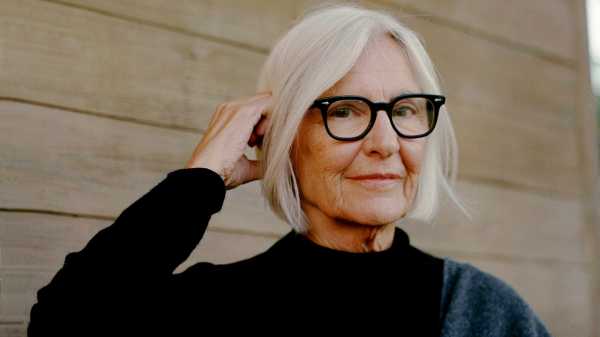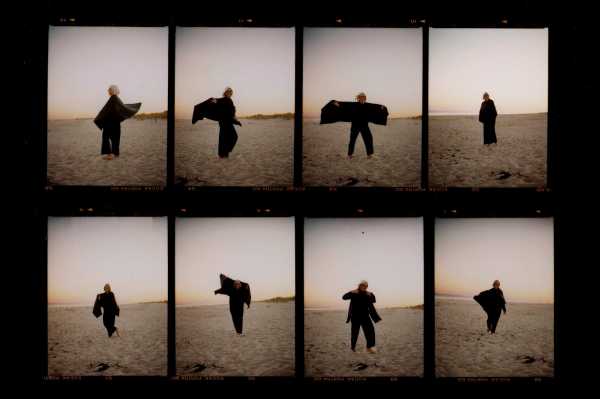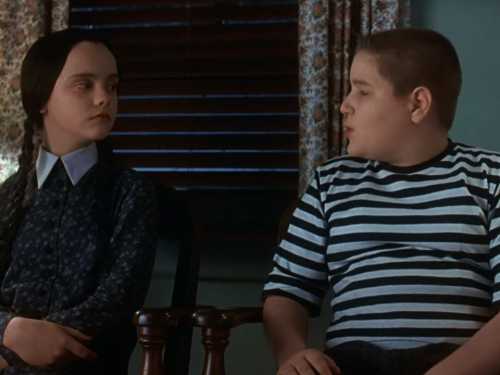
“It’s funny. There’s all this change. All this cultural stuff,” Eileen Fisher says, “and I’m always interested in what’s timeless, or what *doesn’t *change.” She is speaking to me from her patio in Amagansett over Zoom, a week after she’s announced the hiring of a new C.E.O. for her namesake clothing business. I keep trying, and failing, to take her temperature on various cultural shifts—to ferret out any exceptions to the overwhelmingly neutral and timeworn principles that inform her world view. Fisher founded the brand, in 1984, and her clothes have been hailed (or dismissed) as: simple, tasteful, dignified, anonymous, elegant, comfortable, matronly, refined, smart. But the main tenet of Fisher’s design philosophy is timelessness—a stubborn and refreshing aversion to trends. The most whimsical thing Fisher owns is a pair of yellow shoes, she tells me. Her biggest sartorial experiment of late has been a little bucket hat that she wears to the beach sometimes.
And yet, as a business, the story of Eileen Fisher is one of predicting the times rather than transcending them. In a somewhat atypical move, Fisher decided to hire a head of social consciousness twenty-nine years ago, decades before corporate activism became fashionable. Always drawn to the comfort of natural fibres, she was concerned with the environmental impact of her clothing before sustainability became an inescapable buzzword. She launched a clothing trade-in program before resale and “upcycling” were the norms. She has always operated under a more collaborative, nonhierarchical corporate structure that certain Silicon Valley types now claim to aspire to. Aesthetically, Fisher has been prescient, too. Inspired by the architecture and simplicity of the kimono, she set out in the early eighties to make defiantly simple wardrobe basics that would stand the test of time. Today, “elevated basics” dominate fashion from top to bottom, from startup darlings such as Everlane to luxury brands such as the Row.
But, while the clothes that Fisher produces are simple, designing them is not. At seventy-two, Fisher is taking baby steps toward retirement, refocussing her energies on design work and stepping away from the more commercial side of the business. Recently, she announced she would hire a C.E.O. for the first time in the company’s history, appointing the Patagonia executive Lisa Williams. Fisher will spend some of her time insuring the legacy of the brand by teaching young designers at the company to carry on her custom of “undesigning,” as she calls it, or finding the simplest version of a garment that lies underneath all the fuss.
I have to imagine that, when the news broke that you were stepping down from your role and bringing in a new C.E.O., people thought you were announcing your retirement.
I’m not really going anywhere, but just doing more of what I love. It’s a little confusing . . . artists, designers . . . it’s not that you don’t get to retire, but you don’t exactly retire in the same way that others do. It’s in your soul. It’s a part of you.
How will your work change moving forward?
If I think about where I’m headed, I’m passionate about design, but I’m very passionate about the environment. I don’t know exactly what my role is going to be, or what my voice is going to stand for beyond the design and the idea of sustainability in the apparel industry. I don’t know, maybe I’ll just want to go to the beach.
Eileen Fisher is known for its nonhierarchical, unconventional corporate structure. What prompted the decision to bring in a C.E.O.?
I think COVID really shifted something for me in terms of really reorganizing the company. It definitely prompted questions of, Who am I? What am I trying to do? What matters? I have so much pleasure in the days I go in and spend with the designers. And then, other days, I’m doing the business parts—some of it I like, some of it was becoming too much. At my age, it feels like it would be nice to just do the parts I love.
The woman you ended up hiring is Lisa Williams of Patagonia, a company that shares a lot of DNA with Eileen Fisher. What was the hiring process like?
It was about making sure that we got someone who shared the values that we’ve worked hard on. We spent about a year. We hired a search group. It was a really deep process, and a lot of candidates. It’s a unique, collaborative kind of company. It’s not easy to just hire a C.E.O. from out there in the real world—the regular world, the corporate world. When I met Lisa, I felt that we were on the same page in the conversations we were having. Concern around overproduction and consumption. What does it mean, and how do you build a company that works and that is sustainable into the future? I also felt like she was a listener. That’s something I value so much.
Eileen Fisher is so often talked about as a “feminine” kind of company. You’ve always sold clothes to women. Was it important to hire a woman?
We didn’t rule out men, but it was important to me. I was hopeful that it would be a woman.
You said that sustainability is more and more important to you. Has that been a gradual evolution for you, or has there been one specific thing that shocked you into action?
Evolution. You sort of do something and it points you to more. I used to say, in the early days, “Just take baby steps and start.” And it just seems to have momentum. You start to see more. And that’s how I would encourage other companies. Just start, take some steps. I visited factories in China, and the water crisis really hit me. I came to understand that issue, and it was a big turning point. I’m trying to remember the first time I heard the phrase “regenerative agriculture.” It wasn’t all that long ago. To understand that it was possible to regenerate land and draw down carbon—that really moved me.
Obviously, words such as “sustainability” and even terms such as “upcycling” are losing their meaning because everyone uses them now. Is it especially challenging for you to communicate to your customers that your clothing actually is environmentally sustainable?
It’s a huge challenge to communicate, and it’s a challenge to stay true to what we say, and to really walk our talk. It’s not simple to say, “We took all these plastic bottles and made shoes!” There’s a lot to try to communicate to the customer: O.K., cellulose is good and regenerative. Rayon is good, but rayon is also untraceable.
There’s too much stuff in the world, so how do we make sense of creating a good and meaningful business, and, at the same time, reckon with overproduction? How do we make more of the good stuff and less of the wrong stuff? That’s one of the things I think a lot about. There’s just too much of the wrong stuff.
What have you learned from your own in-house resale program, Renew?
When we take clothes back, it’s very interesting to see how timeless our clothes really are and how they really do last, because of good-quality materials and simple shapes and how people are willing to buy them the second go-round. But we also learn things about the design, and what is actually recyclable and what breaks down, where the problems are. Out of that came the Third Life program, our felting initiative, and the upcycling. One thing moves you to the next.
Who’s buying Eileen Fisher clothing these days?
I don’t think it’s changing too much. The middle-aged or older customer is our core customer. We are trying to figure out how to speak better to the next-gen customer. With COVID, we had started a big marketing project, but we had to put a lot of expenses on hold. We were tending to our core customers. But now I think it’s time to ask again, How do we spread our wings a little and reach out once more, in a broader way?
You’ve said you struggled during the pandemic, but did you find in any way that customers were drawn to Eileen Fisher’s clothes because of how simple and comfortable they are?
Yeah, it’s sort of who we are. We were struggling to sell silks. Suiting, they didn’t want it. Now they want it again, so it’s all good. We sold leggings. We sold cotton and French terry. Our terry is called Hug—it’s something we’ve sold for a long time, but it was on fire during COVID.
Are larger conglomerates constantly trying to buy Eileen Fisher? How do you respond to those kinds of inquiries?
Fifteen or twenty years ago, I got acquisition inquiries all the time. I entertained a few at a couple of moments and wondered, Wow, is it crazy not to sell part of the company? That’s what everyone else does. People were encouraging me to diversify my own assets. Most of my resources were in the company. That was the point when I decided to do the ESOP [Employee Stock Ownership Plan]. We were in a good position and generating nice profits. Instead of going public or selling to another company, the company borrowed money to buy me out of forty per cent of the company, and then gave it to employees. I’m really proud of it, and I also think that it should be part of our new era of capitalism. I think that companies should have to share profits, or share ownership with employees. It should be a law.
It probably also means you have very little turnover.
Over the years, the turnover has been really low. The past few years, it’s been harder. We had to downsize during COVID. That was tough. But we’re back, and there’s a lot of momentum in the company. Morale is good, and a lot of people are staying. There was the great-resignation thing, which hit us a bit. Some young people we were nurturing left. It’s a little sad.
In practically every type of office these days, you hear, “Gen Z, Gen Z, Gen Z . . . ” Is it the same at Eileen Fisher?
It’s funny. There’s all this change. All this cultural stuff. And I’m always interested in what’s timeless, or what doesn’t change. My daughter might not like this, but I see the similarity between my daughter and myself. Whether it’s the clothes we like, or how we think about certain things, I am interested in what’s timeless and universal and what transcends the age. I think that’s what I kind of try to bring to the design work. Is that going to stand the test of time?
[A noisy plane flies overhead.]
These private planes, I hope they outlaw them. Bad for the environment.
How does your daughter dress?
She’s a minimalist. Quite simple. She doesn’t like to waste. She wears a lot of Eileen Fisher pieces. She wears other people, but I try not to ask her about them. She always comments that she keeps the Eileen Fisher clothes because they last, they’re comfortable, and she loves the fabrics. She’s an architect. She’s got a nice style.
Do you have anything in your closet that could be considered at all whimsical or strange?
Basically, I’m lazy. I don’t really have things like that. For me, it’s a pair of yellow shoes or a red wrap. It’s a little bit of color, but that’s about it. Pretty much simple, just what I do because I’m more comfortable that way. I’ve been wearing a hat lately. A little bucket hat, at the beach. It’s Eileen Fisher.

You’ve spoken in other interviews about your yoga and meditation practice. What role does it have in your life now?
I started doing yoga in my twenties and let it fall away, then picked it back up about twenty or twenty-five years ago. Basically, I started doing hatha, Kripalu yoga. I had a teacher who studied there and taught me all the postures, and I would go on yoga retreats. Then I got into meditation. I went to the Chopra Center about fifteen years ago. [Laughs.] That’s when I started meditating every day and really leaned into a regular practice. I’d get up every morning and meditate for a half hour before I would do anything. Then I started realizing I couldn’t just sit for a half hour because I needed more movement. It’s amazing, it changed my life. I can wake up totally stressed, but I know that, once I start doing the yoga, I’m good. Even this morning, I was so stressed about doing this interview. I thought to myself, As soon as I do yoga, I’ll feel better. And I did.
I love energy in general. Especially at my age, to feel like, Wow, I can actually build up my energy. I love that! Energy is something I’m always kind of tuned into. That’s kind of been a certain part of my success. Whether it’s the energy between people, where people light up around a fabric or a garment, or a certain kind of energy . . . I read that, and I work from that, and I love that.
Were you involved in any of the holistic, countercultural stuff back in the nineteen-seventies? The health-food movement? Hippie stuff?
Not exactly. I was a hippie, sort of. But I wasn’t embedded in it, really. I got involved in a spiritual group. Are you familiar with Gurdjieff? He’s more like a spiritual philosopher, sort of. It’s really about knowing yourself and tuning into what you’re doing, and why you’re doing it, and how you’re doing it. Being self-aware about your emotions and things like that. It was interesting. But it was kind of cultish. That was part of the problem.
It was later that I got involved in going to Kripalu, and Omega, and the Chopra Center. I went to India. In the seventies, I think I was a little lost. I was in my twenties and I was into design. I had a Japanese boyfriend, and I did go to Japan. But I wasn’t in the spiritual or health-food world much at that point. It intrigued me, but I just didn’t happen into it, somehow, until later.
You were living in downtown New York in an era that people tend to romanticize a lot—the late seventies and eighties. Did you ever brush against any of the kind of mythological cultural scenes?
It’s funny—I was never a part of the scene, so to speak. But I had a lot of artist friends. I loved being around artists. And, when I started my business, it was because I was in Tribeca and around artists, and artist friends. I got a lot of encouragement for my idea. It was artists and creative people who I was drawn to. But they weren’t the famous people, like Andy Warhol. [Laughs.]
You’ve spoken a lot about being inspired by Japan. Are you still drawing fresh inspiration from Japan, or does it all trace back to your original discovery, and your initial line of thinking about the kimono?
I did make a trip to Japan because my kids wanted to go, and that was fun. But really not so much for inspiration. Now, it’s more trying to finish what I set out to do so many years ago.
What’s your relationship to young designers like? Emily Bode told the Times she looked to you for guidance in her work.
I have a bunch of young designers in the company. Other outside designers, it’s kind of tangential. I’ve met some of them, like Stella McCartney and Rachel Comey. It’s funny—even in the company, it’s always such a dialogue around design. Why this? Would it be better like that? Is this really timeless? So I don’t think of myself as mentoring, but I do think that I have something to share. So sometimes I think about a design school. It’s what I’m pondering as I’m separating more from the work. I’m talking about creating the blueprint for what I’m trying to do. What’s the design philosophy? What about it needs to be set down, so that it doesn’t go off [course]?
I think about Kate Spade sometimes. How hard that must have been for her, to sell the company and to see it go somewhere so far from where she originally conceptualized it. And yet it had her name on it. There’s something very personal about those kinds of things. I knew her, but I don’t know her whole story. If I think about it, it makes me sad. So then I think, What does that mean for me? How do I want to preserve [Eileen Fisher] as I leave?
There is a whole other layer to consider with legacy when the brand is your actual name.
Yeah, it’s a little bit weird. I tried hard to have it not be my name, but it got away from me. Because it was early days, and I couldn’t come up with another name, and it was too late, and I just had to do it. So then it started to build traction, and it had my name on it. And so that’s what it was.
Now the name is so iconic that it’s bigger than you.
I hope it is bigger than me. The ideas should be able to live on. Sometimes I compare it to the idea of Bauhaus designs. Of course, that sounds grand, and I don’t mean that. But it’s just that there are principles of design. It’s not rocket science, it’s not only mine. It’s more like undesigning and discovering what the simplest thing is underneath, somehow. And teaching people how to do that.
I think of you and Issey Miyake as being in a similar vein in some ways. Did you ever have a relationship to his clothes, or to him personally?
It’s weird, because I’ve never owned a piece of Issey Miyake, even though I love the way he works and thinks. Somebody gave me his books a long time ago, in the early days. Probably before I even started designing clothes. He totally inspired me. He is an incredible artist. He thinks about clothes the way I think about clothes—and that sounds weird, because his clothes are so much more artistic. Mine are the ultimate simplest version of the kinds of things he does. He talks about straight lines and architectural shapes, and I love that kind of thing. But mine are just utterly daily life, wearable simplest things. His are much more artful. I never got to meet him.
You were profiled, in 2013, in this magazine, by Janet Malcolm. I never had the opportunity to meet her, but I have to ask what it was like to be profiled by her.
It was easy to talk to her and all that. But it turned out that . . . the article was hard for me. I think she seemed to like it. She titled her book the name of it. It was called “Nobody’s Looking at You.” I must have told her the story about how my mother used to say that to me all the time.
Something was tough about it. I saw myself as not communicating clearly. I saw the kind of circular way I told my story in the several days that I met with her. I felt sad, like I hadn’t gotten across who I was somehow. Or maybe she didn’t get me, or maybe I wasn’t being clear. That’s what I came to.
I’m looking at my notes now, and I’m thinking, Oh, gosh, did I just ramble around? I’m trying to be clear. I’ve worked so hard to find my voice. It’s painful. To be clear about who I am and what I’m trying to do and what I think matters. I guess I feel like I have a little opportunity to kind of heal something for myself through this interview. That’s a lot of pressure for you. Make me sound smart and cool. ♦
Sourse: newyorker.com






